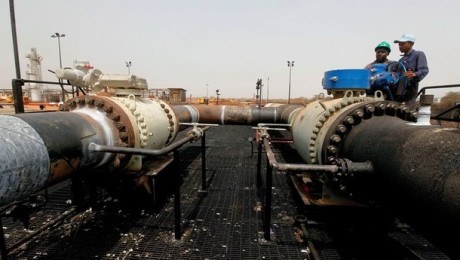Sudan’s Bashir calls for increased efforts to protect oilfields
February 14, 2014 (KHARTOUM) – The Sudanese president Omer Hassan al-Bashir has instructed the minister of oil Makkawi Mohamed Awad to double efforts to protect oilfields in coordination with oil producing states.

Awad said in press statements following his meeting with Bashir on Thursday that he briefed the president on his ministry’s efforts to increase oil production and solve problems with its partners.
The meeting came in wake of the minister’s inspection tour of oilfields in bloc 6 which falls under the concession of Petro-Energy Operating Company (PEOC) including fields of Baleela, Muga, Jeek, and Ki.
Awad stressed his ministry’s commitment to increasing oil production in order to compensate for oil loss which resulted from the secession of South Sudan through developing existing fields, adding new fields and intensifying exploration activities.
Sudan lost 75% of its oil reserves after the southern part of the country became an independent nation in July 2011 denying the north billions of dollars in revenues. Oil revenue constituted more than half of the Sudan’s revenue and 90% of its exports.
He called on PEOC to accelerate the pace of production particularly as the country depends on crude oil produced in bloc 6 to provide oil derivatives, pointing that his ministry raised the slogan of increasing productivity.
The cabinet economic development sector headed by the minister of finance, Badr al-Deen Mahmoud, has approved the oil ministry’s 2013 performance report which the minister submitted on Thursday.
The report indicates that oil reserves in Sudan have added 13.8 million barrels this year through nitrogen injection technology. It also shows the level of performance in refining oil crude in Khartoum and al-Obaid refineries have reached %89 while daily crude production reached %83.
Nitrogen injection is an Enhanced Oil Recovery (EOR) technology that uses nitrogen as the gas to improve oil recovery.
The report mentioned some security constraints which participated to lowering performance of the two-dimensional seismic survey, affirming the three-dimensional seismic survey achieved % 93 performance rates.
Seismic surveys are used to locate and estimate the size of underground oil and gas reserves. Seismic images are produced by generating, recording and analyzing sound waves that travel through the Earth.
The report further pointed that the targeted performance rate for oil wells drilling was achieved.
The cabinet meeting praised the performance of oil ministry, stressing the need to intensify efforts to increase oil production as well as disposing of hazardous materials in coordination with the ministry of environment, forestry, and urban development.
Last September, the Sudanese government lifted fuel subsidies which almost doubled their prices leading to wide protests across the country.
A gallon of gasoline now costs 21 Sudanese pounds ($4.77 based on official exchange rate) compared to 12.5 pounds ($2.84).
Diesel also went from 8 pounds ($1.81) a gallon to 14 pounds ($3.18).
Cooking gas cylinders are now are priced at 25 pounds ($5.68) from 15 pounds ($3.40).
Sudan currently produces 133,000 barrels of oil per day (bpd). The country’s production is stationed mainly in Heglig area and its surroundings as well as western Kordofan.
Following secession of South Sudan, several foreign companies started exploration in new oil fields.
A Saudi company is working in Block 12 which is located in Sudan’s north-western corner near the borders with Libya, and a Canadian company shares exploration with the Sudanese company Sudapet in Block 14.
Sudan Energia is working in Block 18 which is located to the west of the river Nile. Block 11 is located in Kordofan, while Block 9 is located in the Gezira, Khartoum, and River Nile states.
Blocks 13 and 14 are on the coast of the Red sea, while Blocks 19, 22, 21 are inside the red sea. Block 10 is located between Kassala and Al-Gedaref states in eastern Sudan, and Block 8 is located in Sennar state.
(ST)
